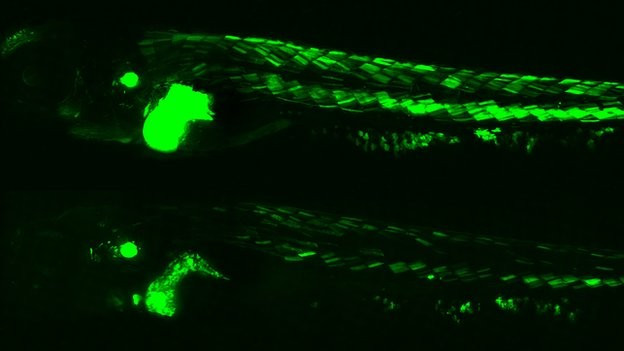Green Glowing Zebra Fish Provides Fresh Insights Into Hazardous Health Effects of Pollution

A genetically altered zebra fish containing an estrogen inducible promoter has enabled researchers to find the hazardous health effects of environmental chemicals in the body.
Scientists at the University of Exeter and UCL (University College London) have made the finding with the help of the fluorescent fish wherein the body environmental chemicals act.
Environmental estrogens are chemicals that can alter hormone signalling in the body. Earlier research indicated that exposure to these chemicals in humans has been associated with increased incidences of breast cancer, testicular germ cell cancer and urogenital tract malformation.
To understand the potential health impacts of such chemicals both in animals and humans, the scientists have created an estrogen responsive transgenic zebra fish for detecting estrogenic signalling of natural (endogenous) hormones.
The research published in the recent edition of the journal Environmental Health Perspectives mentions that the transgenic zebra fish produced are highly responsive to environmental estrogens and identify a wide range of target tissues, most of which have not been reported previously.
Besides this, the report says the fish showed that different EDCs induced different tissue patterns and response time trajectories.
The National Geographic reported that endocrine disruptors, found in many industrial products like plastics and in many female contraceptives, mimic the actions of sexual hormones, resulting in various reproductive problems in both people and animals.
"We've essentially put genetic elements within the fish, over times, that are specifically designed to identify where the chemicals penetrate and act within the body," the National Geographic quoted study leader Charles Tyler at the UK's University of Exeter as saying. "This genetic machinery produces proteins which don't interfere with the way these chemicals act in the body, but they fluorescence green under a fluorescent microscope, providing a reporting system to identify which body tissues is being affected."
As per the report, the research team tested the fish's sensitivity to different chemicals known to affect oestrogen hormone signalling, including ethinyloestradiol, used in the contraceptive pill and hormone replacement therapy treatments.
Eventually, they produced a fish that was sufficiently sensitive to the chemicals to give fluorescent green signals to show which parts of its body were responding. This was done by placing a genetic system into the fish that amplifies the response to oestrogens producing the fluorescent green signal.
"By being able to localise precisely where different environmental oestrogens act in the body, we will be able to more effectively target health effects analyses for these chemicals of concern. While it is still early days, we are confident that our zebra fish model can help us better understand the way the human body responds to these pollutants," corresponding author Professor Charles Tyler of Biosciences at the University of Exeter said.
© Copyright IBTimes 2024. All rights reserved.






















